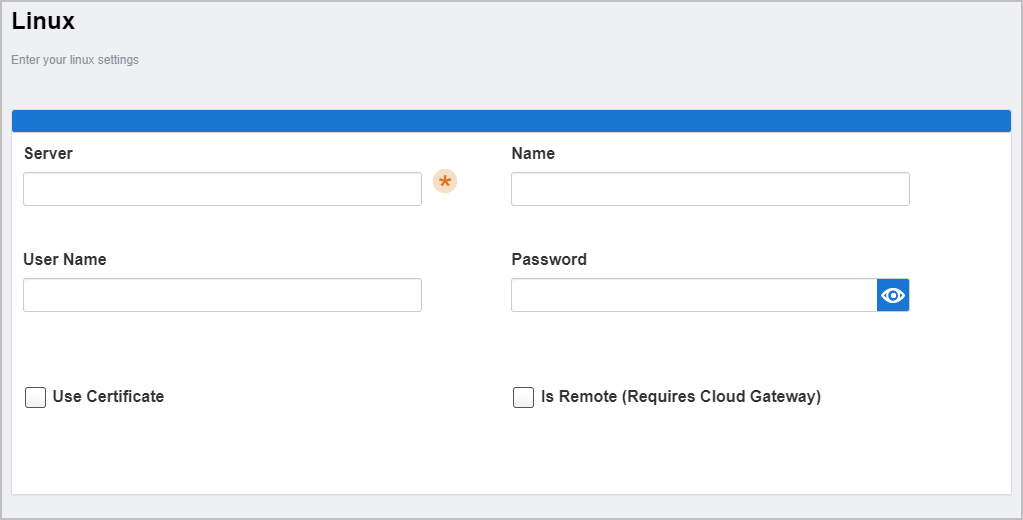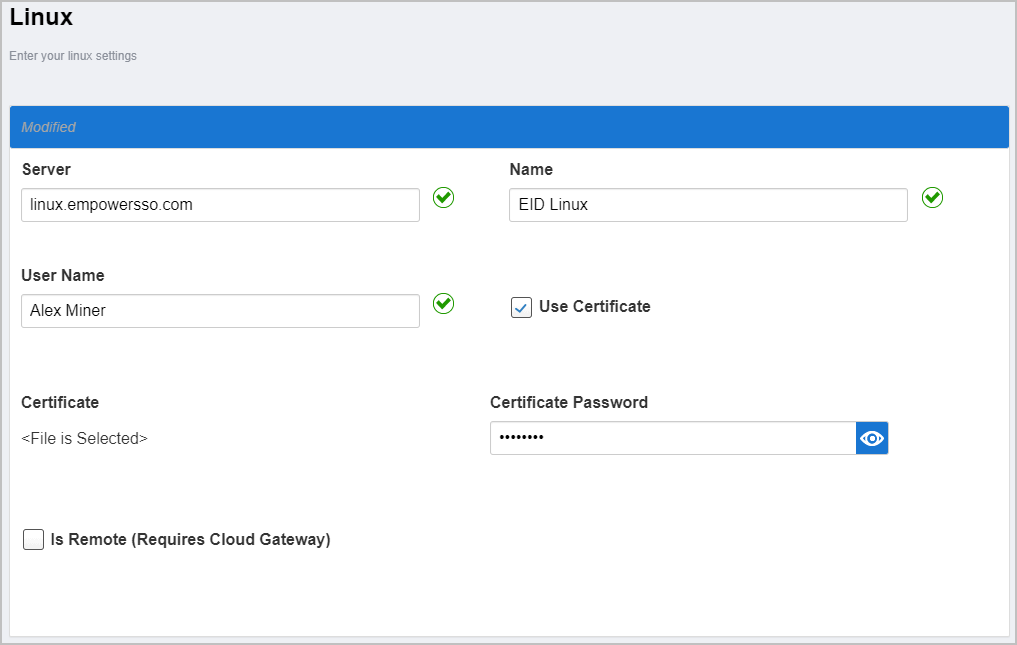...
...
...
In Configuration Manager, select the Account Stores node and then click the Add New button above the grid.
...
In the Add New Security Boundary window that opens, select Linux from the Security Boundary drop-down and then click OK.
...
...
...
To configure the Linux account store
...
| title | General Pane |
|---|
This pane is used to set general configuration information for the Account Store.
...
Connection Account - This is the proxy account you specified EmpowerID use to connect to and inventory the Linux server.
...
Maximum Accounts per Person - This specifies the maximum number of user accounts from this domain that an EmpowerID Person can have linked to them.
...
Icon - This is the image icon that represents this account store in the EmpowerID user interfaces.
...
Enable Pass-Through Authentication - This allows domain authentication to be used for logging in to EmpowerID. Unless Simple Search is enabled, the domain\username format needs to be used.
...
Enable Simple Username Search for Pass-Through Authentication - Simple search works in conjunction with pass-through authentication to allow users to log in without specifying a domain name. When this is enabled, EmpowerID first checks to see if the user name entered exists within its metadirectory and if so attempts to authenticate as that user. If a matching logon name exists but the login fails, EmpowerID then searches through all Accounts Stores where simple username search is enabled to find the correct user name and password combination. To enable this function, click the Enable Simple Username Search button to the left of the line and toggle it so that the green check is visible.
...
Allow Password Sync - Enables or disables the synchronization of password changes to user accounts in the domain based on password changes for the owning person object or another account owned by the person. This setting does not prevent password changes by users running the reset user account password workflows. To enable this function, click the Allow Password Sync button to the left of the line and toggle it so that the green check is visible.
...
Allow Person Provisioning - Allows or disallows EmpowerID Persons to be created from the user records discovered during inventory.
...
| title | Inventory Pane |
|---|
This pane is used to enable or disable inventory of the account store as well as to set the run schedule for the EmpowerID Inventory Job.
...
Enable Inventory - This allows EmpowerID to inventory the Account Store. The Inventory Job must be enabled for inventory to occur. This is discussed further in the below section.
...
Allow Automatic Person Provision on Inventory - This allows EmpowerID to provision EmpowerID people for new accounts discovered during the inventory process if they meet the Provision Rule specified by theCustom_Account_InventoryInboxGetAccountsToProvision SQL stored procedure. This setting is discussed further in the below section.
...
Allow Automatic Person Join on Inventory - This allows EmpowerID to join newly discovered accounts to people during the inventory process if they meet the Join Rule as specified by theCustom_Account_InventoryInboxJoinBulk SQL stored procedure. This setting is discussed further in the below section.
...
RBAC-Assign Initial Group Membership On First Inventory - This setting pertains to Active Directory account stores only.
...
Re-Inventory - Enabling this option re-inventories all changes.
...
| title | Group Membership Reconciliation Pane |
|---|
This pane is used to enable or disable and schedule group membership reconciliation for the domain. When this function is enabled, EmpowerID dynamically manages the membership of the account store's groups, adding and removing users to and from groups based upon policy-based assignment rules.
...
Enable this Functionality - Enables and disables group membership reconciliation on the Account Store.
From the General pane of the Account Store Details screen, enable each desired feature by toggling the icon to the right of each feature from a red sphere to a green check box. For example, if you want EmpowerID to provision an EmpowerID Person for each Linux user, toggle the red sphere to the right of Allow Person Provisioning to a green check box.
In the Inventory pane of the Account Store Details screen for the account store, toggle the icon to the right of the Allow Automatic Person Provision On Inventory setting from a red sphere to a green check box if you enabled Allow Person Provisioning in the General pane and you want EmpowerID to automatically create a linked EmpowerID Person object for each new, unique Linux user discovered during the inventory process.
If you are allowing automatic person provision on inventory, Click the Edit button to the right of Business Role for New Inventory Provision and select an appropriate Business Role for each new Person provisioned during inventory.
Click OK to close the Business Role Selector.
If you are allowing automatic person provision on inventory, Click the Edit button to the right of Location For New Inventory Provision and select an appropriate Location for each Person EmpowerID provisions during inventory.
Click OK to close the Location Selector.
The last step is to enable inventory. To do so, toggle the red sphere to the left of Enable Inventory so that it becomes a green check box.
After several minutes, refresh the account store data by pressing the Refresh Data button located a the top of the Account Store Details screen. You should see that EmpowerID has inventoried the user and groups in your Linux server and provisioned the requisite number of EmpowerID Persons for those accounts (if you selected the provisioning options discussed above).
...
| icon | false |
|---|
...




